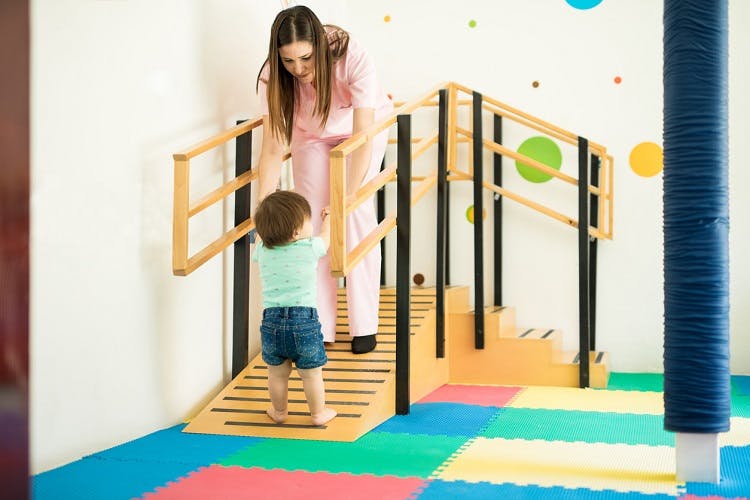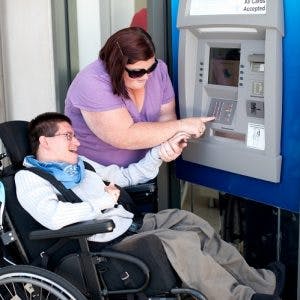Hypotonic cerebral palsy refers to when individuals with CP primarily experience low muscle tone. This often affects posture and stability and makes it challenging for individuals to balance and coordinate their movements.
Moreover, hypotonia is considered a rare outcome of cerebral palsy because most individuals experience the opposite effect: hypertonia (high muscle tone). However, it is possible for people with cerebral palsy to experience a combination of hypotonia and hypertonia in different muscles of the body.
To help you understand what to expect when your loved one has hypotonic cerebral palsy, this article will discuss:
- Causes of hypotonic cerebral palsy
- Signs of hypotonic cerebral palsy
- Goals of treatment for hypotonic CP
- Hypotonia management
Causes of Hypotonic Cerebral Palsy
To understand what causes hypotonia in individuals with cerebral palsy, it’s critical to understand the relationship between the brain and muscles.
Muscle tone is primarily regulated by the transmission of signals from the brain. These signals travel down the spinal cord and through the nerves to the muscles where they are directed to contract or relax.
Cerebral palsy is a motor disability caused by damage to the brain before, during, or shortly after birth. As a result, individuals with cerebral palsy often experience abnormal muscle tone due to disrupted communication between the brain and muscles.
While individuals with any type of cerebral palsy may experience hypotonia, it is most commonly associated with ataxic CP. This type of CP is caused by damage to the cerebellum, which is the area of the brain mainly responsible for regulating balance, coordination, and fine motor skills.
Most individuals with hypotonic cerebral palsy are diagnosed by the time they reach 6 months old. However, hypotonia may go unnoticed for several years in individuals with mild CP. In the following section, we’ll discuss signs of hypotonic cerebral palsy.
Signs of Hypotonic Cerebral Palsy
Every case of cerebral palsy is unique. Depending on a variety of factors such as the severity and location of brain damage and the onset of secondary complications, individuals with hypotonic cerebral palsy may experience a wide range of effects.
Signs of hypotonic cerebral palsy include:
- Floppy limbs
- Poor head control
- Developmental delays
- Clumsiness/ frequent falling
- Excessive flexibility
- Slow movements
- A soft or weak voice
- Poor trunk stability
- Difficulties chewing or swallowing
- Wide-based stance while standing or walking
- Low activity tolerance
Because infants develop motor skills over time, signs of low muscle tone are often overlooked until the child gets older and demonstrates developmental delays or motor impairments. By identifying signs of hypotonia and seeking early management as soon as possible, parents can proactively minimize the impact of low muscle tone on their child’s everyday life.
Hypotonic Cerebral Palsy Treatment Goals

Early management of hypotonia in individuals with cerebral palsy is crucial to maximizing your child’s mobility.
Children’s brains have greater amounts of neuroplasticity than those of adults, which makes it easier for them to adapt and learn new skills. Neuroplasticity refers to the brain’s ability to reorganize its neural circuitry. It allows for functions affected by brain damage to be relearned and improved by healthy, undamaged regions of the brain.
The most effective way to promote neuroplasticity is through highly repetitive and task-specific training. Consistent practice stimulates the brain and encourages neurological adaptations.
However, it’s important to understand that adaptive changes can be beneficial or harmful. The movement patterns your child continuously practices are the ones that become solidified pathways in their brains and develop into habits. Therefore, the earlier abnormal movement patterns caused by hypotonia are addressed, the better the long-term functional outcomes.
Hypotonia Management
Because hypotonia can range from mild to severe, a personalized approach that targets each individual’s specific motor impairments is ideal.
Management interventions for hypotonic cerebral palsy may include:
- Physical therapy. A physical therapist will assess the client’s motor skills and develop a personalized exercise regimen to strengthen underused muscles and improve form.
- Occupational therapy. Occupational therapy can help individuals with hypotonia learn how to be as functional as possible by practicing everyday activities such as eating, dressing, and grooming. Depending on the severity of your child’s hypotonia, an occupational therapist may also teach your child how to use adaptive equipment. They can also focus on the development of skills needed for participation in school, such as fine motor precision skills for handwriting.
- Speech therapy. If hypotonia affects the muscles around the mouth, individuals may struggle with feeding or speech. By working with a speech-language pathologist, individuals with hypotonic cerebral palsy can practice exercises that help strengthen the oral motor muscles or learn alternative ways to be effective communicators.
- Orthotic devices. Orthotic devices like braces, splints, and casts can provide additional musculoskeletal support which promotes correct form and minimizes the risk of falling.
Ultimately, management of hypotonia in individuals with cerebral palsy focuses on promoting functional independence and preventing further muscle weakness. By consistently practicing targeted exercises and activities, individuals with hypotonia can reinforce demand in the brain for those functions and promote neuroplasticity.
Cerebral Palsy and Hypotonia: Key Points
Individuals with hypotonic cerebral palsy experience low muscle tone, which can affect their balance and coordination skills. As a result, they may be prone to falls or struggle with tasks that require precision.
Fortunately, individuals with hypotonia can train their brains to make neurological adaptations and rewire these skills to undamaged regions of the brain. By strengthening underused muscles and consistently practicing movements affected by low muscle tone, individuals can significantly improve their functional independence.
We hope this article helped you better understand what hypotonia is and how it can affect individuals with cerebral palsy.










